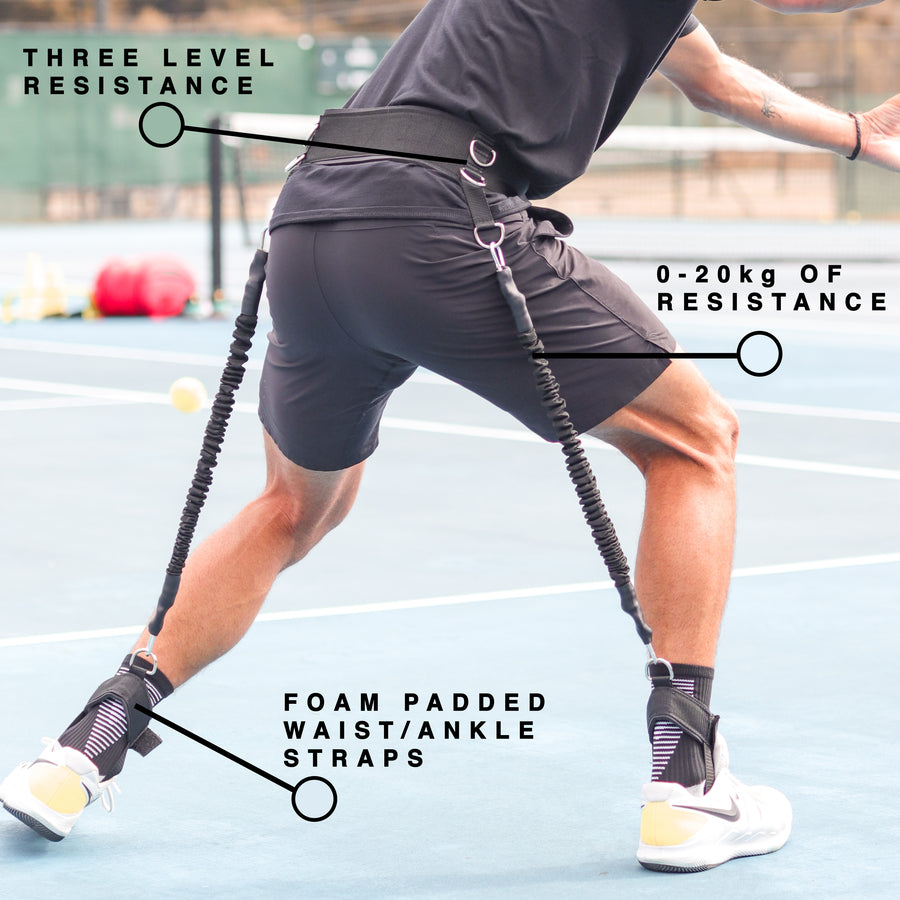Science of Training with Resistance Bands
INTRODUCTION
In recent years elastic resistance training (ERT) has become a growing trend and popular method for training. Training with resistance bands is categorised into a training method known as ‘variable resistance training’. When an exercise is supplemented with the use of elastic bands, a variation in the load being lifted occurs throughout the range of the movement. Hence the name ‘variable’ resistance training. This differs from the constant weight you lift with free-weights (dumbbells, kettlebells etc.). Resistance band training has been scientifically proven to be effective as a training method. They cater for the needs of aspiring athletes, injured clients, elderly, gym junkies, and recreational users. Their lightweight, low impact, affordable, easily transportable, storable and color coded properties prove appealing to their users compared to free weights. Not to mention their extreme versatility when it comes to working on different muscles and exercises. Resistance Band Training originated in the early 20th Century where they were prescribed for use in a rehabilitation sense and initial resistance bands were made from surgical tubing. As time and knowledge of the human body advanced so did resistance band training. Today they are not only being used for rehabilitation but for all walks of recreational, professional and aesthetic development.
TRAINING WITH RESISTANCE BANDS VS FREE-WEIGHTS:
Resistance bands are commonly used by many top athletes around the world, from Roger Federer to Connor Mgregor. The versatility and performance enhancing features that you can utilise from using resistance bands compared to free weights are as follows.
More Plains of Movement- Free weights rely on a gravitational force which is always a constant. Newton's law W=(m)(g) (Weight=mass x ((gravity (which is directional)). Free weights produce a vertical directional force due to gravity which in turn limits your range of exercises and your ability to target specific muscles. This means that if you do an exercise with a free weight in the horizontal plane such as moving your hand from the left side of your body to the right side while holding a dumbbell there’s no horizontal resistance to that movement. Exercises like this limit your ability to target one single muscle. As you move the free weight across your body you involuntarily turn on and turn off different muscles to compensate for the force that is essentially moving.
Resistance bands produce a spring force which does not rely on gravity. Hooke's Law ((Fs)= (k)(x) k=spring constant x=spring stretch)) states a spring force does not have a gravitational component to it. Thereby this spring force can be applied in many different directional plains to target more specific muscles. This means that if you do the same previous exercise with a resistance band in the horizontal plane- moving your hand from the left side of your body to the right side there is a constant horizontal resistance to that movement. High performance sports training is becoming more and more refined, where coaches and athletes work harder on the tiny details that promote success. The ability for a tennis player or baseball player to specifically target the rotator cuff muscles or a gymnast to target their ankle strength is vital for their success at a high level. Resistance bands allow the directional resistance required to improve these areas where free weights can not.
This study proved an increase in serve speed for college tennis players after only 4 weeks of resistance band training https://pubmed.ncbi.nlm.nih.gov/9689369/.
Constant Tension- Resistance bands can provide a constant tension throughout the full range of your exercise where free weights can not. Training with a constant tension means you can maintain more direct and precise muscle activation and get the full benefit of each repetition. Free weights rely on gravitational resistance so sometimes at the outer range given exercises there is less muscle activation. As we talked about earlier when you move a free weight in any direction outside the vertical plain certain muscles are required to switch on and switch off to compensate for the varying force distribution. For example if you wish to achieve maximal effect from a bicep curl you could argue it would be best to train with resistance bands than free weights. With a free weight bicep curl if your elbow gets too high you will only achieve good muscle activation until you pass the 90 degree mark. At the very top of this movement the dumbbell will be falling towards your shoulder due to gravity and there will be less tension on your bicep. If you use a resistance band the constant elastic tension will maintain the stress you want on your bicep throughout the full range of motion. Essentially you get more out of each repetition from the resistance band in this scenario.
Variable Resistance- What is variable resistance? As the range of motion of an exercise increases, so, too, does the resistance provided by the band. This is arguably the biggest benefit and difference to training with free weights. For example using the bicep again, as you begin to curl your bicep with resistance band elastic tension, it is easiest at first and gets progressively harder to curl towards the outer range of the motion (towards your shoulder). This is due to the molecular properties of elastic. As your resistance bands tension force increases the amount of muscle fibres recruited to perform the motion increases also. The more muscle fibres recruited the greater the adaptations in muscular strength. The “strength curve of a muscle” refers to how a muscle or muscle groups strength changes over a given range of motion. Most muscles increase in strength across a selected movement until a certain point where your strength then decreases. Again with the bicep curl, as you bring your bicep towards your shoulder your bicep muscle gets stronger until about the halfway point of motion. Thus, the biceps muscle is weakest at the start of the exercise and strongest at the halfway point. So when you bicep curl a free weight you are limited by the weight you can curl by how strong the bicep is at its weakest range of the curl motion (the beginning of the exercise). This means the muscle isn't receiving adequate resistance at its strongest point in the range of motion. Whereas with resistance bands and their linear variable resistance (gets stronger the more you stretch it) you are able to receive maximal gain of the exercise at your strongest point. It therefore becomes more achievable to reach your maximum strength limit with resistance bands than free weights. To wrap this section up you are able to recruit more muscle fibres which in turn promotes better strength adaptations. Studies from Truman State University (Kirksville, Missouri) and University of Wisconsin-La Crosse linked at the end of this thesis have proven that athletes who utilised training with resistance bands in addition to free weights have made greater strength and power gains than those training with free weights alone.
Prevent Taking Shortcuts- When training with Free weights it is easy to gain momentum before then contracting the target muscles. This makes performing the action much easier and takes less effort which therefore means you get less muscle stimulation and less muscular adaptations. Typically beginners who do not have full understanding of the technique required to perform an exercise will do this. Because resistance bands use linear variable resistance rather than gravity it is much harder to use momentum to shortcut an exercise. This is due to the fact that any momentum you try to get with a band only makes the tension of the band harder before you perform the given range of motion. You therefore are likely to get better value out of each repetition you perform with a band than free weights.
Other Features to Consider- “elastic resistance equipment is inexpensive, lightweight, and easily stored and transported, despite its ability to provide strong, heavy-duty resistance. On the contrary, free weights must be heavy and cumbersome to provide substantial load. Barbells, dumbbells and weight plates are expensive, too, as they’re typically priced by the pound.”- Jim Stoppani









